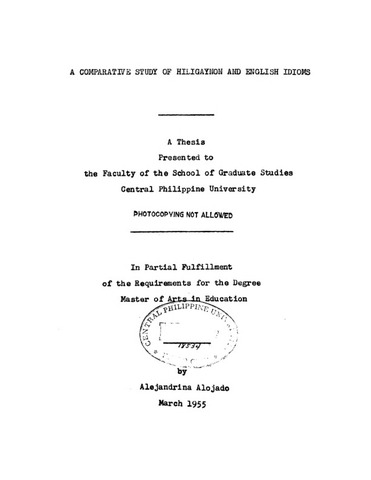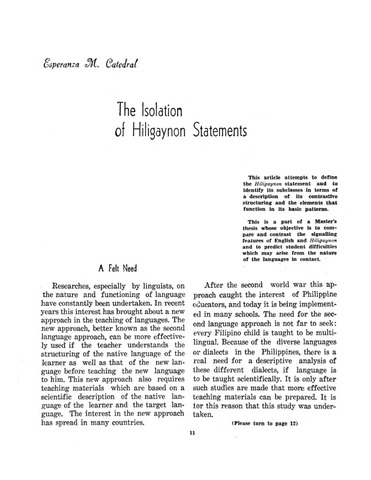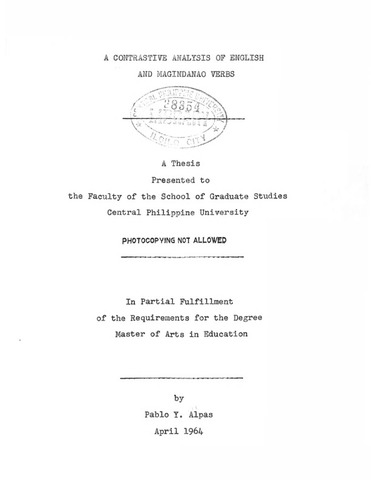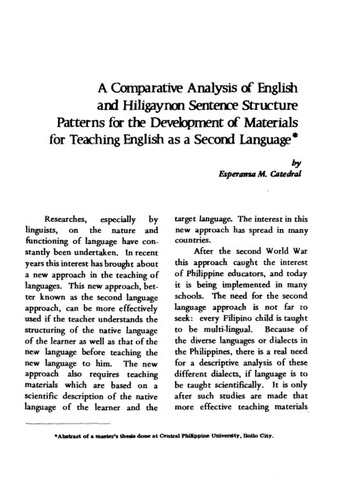A comparative study of Hiligaynon and English idioms
| dc.contributor.adviser | Nelson, Linnea A. | |
| dc.contributor.author | Alojado, Alejandrina | |
| dc.date.accessioned | 2021-12-02T05:38:59Z | |
| dc.date.available | 2021-12-02T05:38:59Z | |
| dc.date.issued | 1955 | |
| dc.identifier.citation | Alojado, A. (1955). A comparative study of Hiligaynon and English idioms (Unpublished Master’s thesis). Central Philippine University, Jaro, Iloilo City. | en_US |
| dc.identifier.uri | https://hdl.handle.net/20.500.12852/1740 | |
| dc.description | Introduction and statement of the problem | en_US |
| dc.description.abstract | When teachers of English get together and talk shop they complain of the weaknesses of their classes both in oral speech and in written work. This observation is not of the English teachers alone but also of other educators and thoughtful Filipinos as well. If it is not grammar that needs correction or wrong choice of word or pronunciation, it is transliteration. Antonio Isidro thinks that in the teaching of English to Filipinos whose background is Oriental and whose speech is radically different from English, the first difficulty is in the use of Idiomatic expressions. This difficulty has two sources. First, the Filipino child speaks his vernacular at home, in the school grounds, and in the community. He then develops his language and his methods of thinking in the pattern of the vernacular. Therefore, for about seven or eight years the child thinks and speaks in the vernacular, adopting language habits peculiar to his dialect. Second, idioms, the life blood of any language are best learned through direct contact with the native users of the language. Filipinos do not have adequate contact with native speakers of English. All the contact they have is through books, and generally in the classroom only. How then can students be helped in the use of idiomatic expressions? The late J. Scott McCormick had felt the need of helping students overcome this difficulty. When he was head of the Academic Division of the Bureau of Public Schools, he asked the teachers working with him on a textbook project to prepare lists of common errors of idioms which were the result of the literal translation of the dialect to English with the hope that this list together with the corrections could be of help to both teachers and students. It is the purpose of this study to compare Hiligaynon and English idioms in order to help students avoid transliteration of Hiligaynon to English and vice versa. It also hopes to develop the students' vocabulary. When a student of inadequate experience and limited vocabulary is urged to think he naturally thinks in the dialect thought symbols. After studying these compared idioms it may be expected that instead of thinking of the Hiligaynon idiom he will give the English substitute. It will be less discouraging for him to do this than for him to think of the right expression and when he finds that, to be told that it is all wrong. This study should be a help to students while they improve their cultural contacts. Eventually, they can be on their own and will find the "crutch" unnecessary. | en_US |
| dc.format.extent | 103 leaves | en_US |
| dc.language.iso | en | en_US |
| dc.subject.ddc | GSL Theses 378.242 Al7 | en_US |
| dc.subject.lcsh | Idioms | en_US |
| dc.subject.lcsh | English language--Idioms | en_US |
| dc.subject.lcsh | Hiligaynon language--Idioms | en_US |
| dc.subject.lcsh | Hiligaynon language--Translating | en_US |
| dc.subject.lcsh | Grammar, Comparative and general | en_US |
| dc.subject.lcsh | English language--Study and teaching--Foreign speakers | en_US |
| dc.subject.lcsh | English language--Study and teaching (Elementary) | en_US |
| dc.subject.lcsh | Translating and interpreting | en_US |
| dc.subject.lcsh | Language and languages | en_US |
| dc.subject.lcsh | Hiligaynon language | en_US |
| dc.title | A comparative study of Hiligaynon and English idioms | en_US |
| dc.type | Thesis | en_US |
| dc.description.bibliographicalreferences | Includes bibliographical references | en_US |
| dc.contributor.chair | Nelson, Linnea A. | |
| dc.contributor.committeemember | Catedral, Alfredo P. | |
| dc.contributor.committeemember | Larsen, Almus O. | |
| dc.contributor.committeemember | Zaldivar, L. A. | |
| dc.contributor.committeemember | Ortigas, Irene L. | |
| dc.contributor.department | School of Graduate Studies | en_US |
| dc.description.degree | Master of Arts in Education | en_US |





